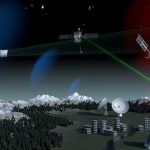Space debris is becoming a bigger problem for space agencies and private companies, and NASA and the Department of Defense (DoD) are just two of many organizations around the globe that are concerned. Earlier this month experts gathered in Germany to discuss the problem and to review possible solutions.
Space debris is becoming a bigger problem for space agencies and private companies, and NASA and the Department of Defense (DoD) are just two of many organizations around the globe that are concerned. Earlier this month experts gathered in Germany to discuss the problem and to review possible solutions.
The DoD maintains a highly accurate satellite catalog on objects in Earth orbit that are larger than a softball, according to the NASA website. NASA and the DoD cooperate and share responsibilities for characterizing the satellite (including orbital debris) environment. DoD’s Space Surveillance Network tracks discrete objects as small as two inches (five centimeters) in diameter in low Earth orbit and about one yard (one meter) in geosynchronous orbit. Currently, about 15,000 officially cataloged objects are still in orbit. The total number of tracked objects exceeds 21,000. Using special ground-based sensors and inspections of returned satellite surfaces, NASA statistically determines the extent of the population for objects less than four inches (10 centimeters) in diameter.
Last week findings from the 7th European Conference in Space Debris were shared and several challenges were discussed on the threats brought about from this debris.
Despite progress in technology, and in understanding the space environment, the need for significantly increasing the pace in applying proposed measures to reduce debris creation was identified at Europe’s largest-ever space debris conference, the European Space Agency (ESA) event April 18-21 at the European Space Operations Centre (ESOC) in Darmstadt, Germany.
Recent announcements of large constellations with several hundreds of satellites in critical orbital regimes has been identified as a potential additional challenge, it was announced at the conference. These were among the findings presented by senior scientists and representatives of the world’s leading space agencies and space-related scientific bodies during a press briefing from the conference.
The event featured a best-ever attendance by some 350 participants from space organizations, academia and industry who delivered hundreds of papers on the latest research into the debris threat and on new technologies aimed at mitigating debris creation and reducing the orbital debris population.
There is wide agreement that the continuing growth in space debris poses an urgent threat to economically and scientifically vital orbital regions. Today’s active satellite infrastructure includes telecom, weather, navigation, broadcast and climate-monitoring missions, and these provide a multitude of critical services and daily benefits to citizens and economies. Their loss, possibly due to their orbits being polluted by debris, would severely damage modern society, according to reports from the conference.
There is a consensus that debris mitigation strategies — many defined long ago — are as important today as ever before. The venting of residual energy from satellites and upper stages at the end of their missions to prevent explosive break-ups, and the disposal of any sort of satellite through a final maneuver remain challenges, said ESA.
Several solutions were presented to support these mitigation measures, and many presentations emphasized that execution of these measures is becoming ever more important in view of the upcoming mega constellations of thousands of satellites in low orbit.
“Fast and reliable implementation of mitigation measures for all missions and a change in the operational paradigm to consider space-object disposal as an important part of the overall mission are essential to contain the growth of the space debris population and to preserve space for future generations,” said Holger Krag, head of ESA’s Space Debris Office and conference chair.
“The conference demonstrated that the technology is available and the need is understood everywhere. However, implementation of these countermeasures is still a challenge, and this has the utmost importance in view of plans to deploy constellations of hundreds of satellites in space.”
Like all missions, such constellations must include provision for safe disposal when their missions end so that they do not contribute to the already unsustainably large population of debris objects.
Since 1957, more than 5,250 space launches have led to an on-orbit population today of more than 23,000 tracked debris objects, according to ESA. Of these, only about 1,200 are functional spacecraft. The remaining are classified as space debris and no longer serve any useful purpose.
A large percentage of the routinely tracked objects are fragments from the approximately 290 breakups, explosions and collisions of satellites or rocket bodies that are known to have occurred. An estimated 750,000 objects larger than 1 centimeter and a staggering 166 million objects larger than 1 millimeter are thought to reside in commercially and scientifically valuable Earth orbits, according to ESA.
Mitigation Map is in Place
Space debris mitigation measures have been adopted by most major space-faring agencies and companies and, if properly implemented by spacecraft designers and mission operators, can curtail the growth rate of the orbital debris population.
Active removal, however, is now necessary to reverse the debris increase, and researchers have seen evidence that the environment in some orbital regions has already reached a critical state. At the upcoming Guidance, Navigation and Control 2017: 10th ESA GNC Conference, May 29, 2017 to June 2, 2017 in Salzburg, Austria, there will be a session on debris mitigation and removal.
“The number of space debris objects in these regions might grow even if mitigation measures are applied,” says Krag. “The technology required for deorbiting is actively being studied today and we saw a lot presented at this conference.”
To prevent this uncontrolled growth, the active removal or deorbiting of selected large defunct space objects is required in addition to the full application of mitigation measures.
Even then, the serious shortfall debris mitigation guideline adherence – and specifically post-mission disposal practices – that were identified by conference participants may yet render such efforts moot.
“We see evidence that fewer than half of the satellites that should be deorbited at end of life are actually commanded to do so, and there is no enforceable international regime to ensure this,” Krag added.
“It’s the classic ‘tragedy of the commons’, except it’s happening in space and could ruin modern technological society for everyone.”
Global Gathering of Debris Experts
The findings were delivered by researchers and specialists from more than 20 nations. The scientific program board of the conference was supported by experts from the DLR German Aerospace Center, France’s CNES space agency, Italy’s ASI space agency, the UK Space Agency, the Committee on Space Research, the International Academy of Astronautics, and ESA.
For the first time in the 24-year history of the quadrennial debris conference series, the media briefing was attended by ESA Director General Jan Wörner and Brigitte Zypries, German Federal Minister for Economic Affairs and Energy and German national aerospace coordinator.
Understanding Debris
ESA was a pioneer in the field of debris research. Together with NASA, ESA is a founding member of the Inter Agency Debris Coordination Committee (IADC), a technical body for space debris experts from 13 space agencies.
IADC formulated and published space debris mitigation guidelines more than a decade ago that are now used in most national standards.
Since 2002, ESA has been monitoring critical conjunctions between its spacecraft and the approximately 20,000 objects that are regularly tracked in orbit. A team of experts at ESA’s European Space Operations Centre in Darmstadt watches over a fleet of, currently, 19 European spacecraft around the clock and triggers several collision avoidance maneuvers per year.
With this perspective, ESA has identified the need for Europe to obtain information on such objects in space through its own surveillance and tracking system. About a decade ago, ESA launched an ambitious space situational awareness program that is meant, in part, to design and develop the required sensor systems in Europe.
Following the Rules
ESA has high standards in implementing and executing space debris mitigation guidelines. For example, ESA’s Vega launchers have conducted all flights in full conformance.
ESA also acts to implement measures for missions that were designed and launched long before current mitigation guidelines were adopted.
ESA’s ERS-2 satellite, launched in 1995, was successfully deorbited in 2011, while Integral and the four Cluster satellites have been maneuvered so as to safely reenter when they reach end of life in a few years.
Compliant disposal measures have also been taken for missions operating near the Earth–Sun Lagrange points, some one million kilometers away.
Cleaning Space
To ensure the competitiveness of European industry in implementing mitigation measures and facilitating adherence to international guidelines, ESA, within its Clean Space Initiative, has established the CleanSat project.
CleanSat has a coordinated approach that involves ESA, system integrators and equipment manufacturers, and is developing and implementing innovative mitigation technologies such as deorbiting systems, demisable equipment, passivation solutions for propellant, and power systems.
These technologies reduce the risk on the ground upon atmospheric reentry and increase the reliability of the essential post-mission disposal functions of satellites. Applicable technologies to approach, capture and safely deorbit a large and massive target object are being studied in ESA.
These range from sensors for the inspection of defunct space objects and their dynamics, capture technologies including nets, robotic arms and harpoons, up to system aspects of a removal mission, according to ESA.
e.Deorbit, a demonstration mission for the removal of a large ESA-owned target objects, has now reached a high maturity level of preparation.
With the development of these technologies and their applications for in-orbit servicing to be provided by future “space tugs”, ESA is also paving the way for new business opportunities for European industry.
Call for a Sustainable Future in Space
“We require a coordinated global solution to what is, after all, a global problem that affects critical satellites delivering services to all of us,” said Brigitte Zypries, German Federal Minister for Economic Affairs and Energy, at a press briefing on the conference’s closing day in Darmstadt.
ESA Director General Jan Woerner appealed to space stakeholders to keep Earth’s orbital environment as clean as possible. Developing and implementing the ESA Space Situational Awareness (SSA) program as decided during ESA’s last ministerial council in 2016 will be a key factor.
“In order to enable innovative services for citizens and future developments in space, we must cooperate now to guarantee economically vital spaceflight. We must sustain the dream of future exploration,” he said.
The call for international action came on the final day of the European Conference on Space Debris.
Addressing the Space Debris Threat
The latest results of debris research were featured, especially the safe disposal of retired satellites and rocket stages and the still uncertain challenges posed by satellite mega constellations being considered by commercial operators.
“Only about 60% of the satellites that should be disposed of at the end of their missions under current guidelines are, in fact, properly managed,” noted Krag.
Researchers also confirmed there is now a critical need to remove defunct satellites from orbit before they disintegrate and generate even more debris.
“This means urgently developing the means for actively removing debris, targeting about 10 large defunct satellites from orbit each year, beginning as soon as possible – starting later will not be nearly as effective,” said Krag.
Last fall, Inside GNSS reported on how the U.S. Air Force’s 2nd Space Operations Squadron (2SOPS) at the 50th Space Wing, Schriever Air Force Base, Colorado, had moved the longest-serving GPS satellite, space vehicle number (SVN) 23, into a disposal orbit several hundred miles above the operational GPS constellation.
Concerns have been expressed in recent years by organizations that have studied the possibility of GNSS satellites, particularly those that have been “parked” in disposal or graveyard orbits, to drift and possibly collide with one another. Decommissioned satellites are switched off and placed into a disposal orbit higher than the operational constellation. Such out-of-service GPS satellites as SVN 23, for instance, are boosted about 500 kilometers (310 miles) further out into space.
In studies for the Air Force early in this decade, Aerospace Corporation researcher Chia-Chun (George) Chao and colleagues predicted that GPS satellites placed in disposal orbits will eventually — in 20 to 40 years — drift down into the operating constellation. Besides intersecting the GPS constellation, these satellites eventually could pose a threat to operational satellites in low Earth and geosynchronous orbits, Chao said.
SVN 23 outlasted all of its predecessors — and even others launched after it. With the implementation of a new launch, anomaly resolution, and disposal operations system (LADO), operators with 2SOPS and the 19th Space Operations Squadron at Schriever successfully disposed of SVN 29 in November 2007.






